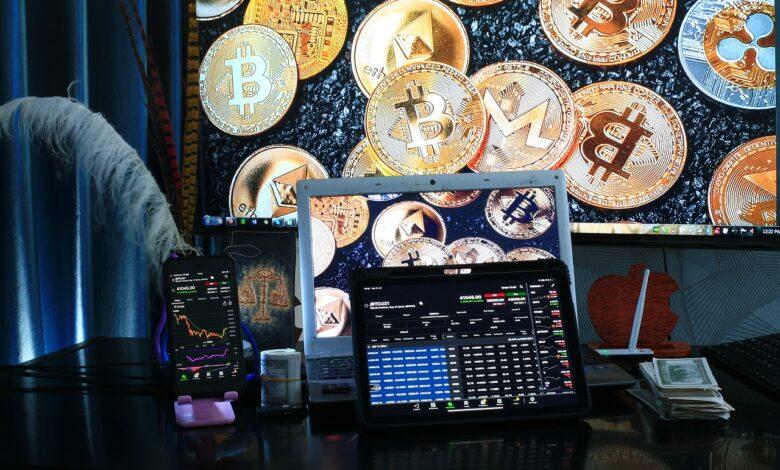Spotting Crypto Platform Red Flags – A Guide

The world of cryptocurrency is an exhilarating yet treacherous landscape, where fortunes can be made or lost in the blink of an eye. As we navigate this digital currency exchange ecosystem, it becomes paramount to develop a discerning eye, one capable of recognizing the red flags that may signal potential risks. Choosing a cryptocurrency platform is not merely a matter of convenience; it requires careful analysis and a keen understanding of the myriad factors at play. The stakes are high, and the ability to spot warning signs can mean the difference between thriving in this volatile market and succumbing to its perils.
When selecting a crypto platform, it is essential to approach the decision with a critical mind. Identifying the nuances that separate reputable exchanges from dubious ones can serve as your first line of defense against the multitude of hazards inherent in digital currency trading. Recognizing these flags involves more than just surface-level scrutiny; it demands a thorough examination of various elements–security protocols, regulatory compliance, user reviews, and the overall transparency of the platform. Each aspect plays a crucial role in ensuring not only your investment’s safety but also your peace of mind.
In our endeavor to foster a more informed community of cryptocurrency enthusiasts, this exploration aims to illuminate the essential practices for spotting red flags during platform selection. With love for this dynamic field and a commitment to empowering others, we will delve deeply into the identifying characteristics that signal caution. By cultivating an awareness of these warning signs, you will be better equipped to navigate the complexities of choosing a digital currency exchange–ultimately minimizing risks and maximizing your potential for success in this brave new world.
How to Recognize Red Flags When Choosing a Crypto Platform
In the ever-evolving landscape of cryptocurrency, selecting a digital currency exchange can be a daunting task. When venturing into this realm, it is crucial to recognize the red flags that may indicate underlying risks. Spotting these warning signs early on can save you from potential financial pitfalls and ensure that your crypto investments are secure. To guide you through this process, we must first identify what constitutes a “red flag” in the context of crypto platforms.
One of the primary indicators to watch for is a lack of transparency. When selecting an exchange, scrutinize the platform’s operational practices and regulatory compliance. A reputable cryptocurrency platform will provide clear information about its governance structure, security measures, and transaction fees. If you encounter vague descriptions or evasive responses from customer service, consider this a significant warning sign. Transparency is not merely a nicety; it is essential for building trust and ensuring the safety of your assets.
Another critical aspect to evaluate is the platform’s security protocols. In a world where cyber threats are rampant, recognizing the importance of robust security measures cannot be overstated. Look for exchanges that employ industry-standard practices such as two-factor authentication (2FA), cold storage for funds, and regular security audits. If a platform lacks these basic protections or has experienced multiple security breaches without adequate remedies, it is imperative to reconsider your selection. Trust must be earned through demonstrated commitment to safeguarding user assets.
Additionally, when choosing a cryptocurrency platform, be wary of unrealistic promises or overly aggressive marketing tactics. If an exchange claims guaranteed returns or extraordinary trading results, it should serve as a red flag. The volatile nature of cryptocurrencies means that no legitimate exchange can promise consistent profits without risk. Identifying such warning signs helps prevent falling victim to scams that prey on unsuspecting investors seeking quick gains.
Moreover, pay attention to user reviews and community feedback. When recognizing potential risks associated with a platform, real-world experiences shared by other users can be invaluable. Be cautious if you notice a pattern of complaints regarding withdrawal issues, poor customer support, or hidden fees; these are often signs of deeper systemic problems within the exchange. Engaging with the crypto community through forums and social media can also provide insights into the reputation and reliability of various platforms.
Lastly, always evaluate the liquidity provided by an exchange. A lack of liquidity can hinder your ability to execute trades efficiently and at favorable prices. When identifying potential platforms, ensure they offer sufficient trading volume across various currencies. A platform with low liquidity could lead to slippage and increased costs during transactions, undermining your overall trading strategy. By being diligent in your research and attentively spotting these red flags, you can make informed decisions that enhance your chances of success in the dynamic world of cryptocurrency trading.
Unlicensed Platforms to Avoid: Recognizing Risks When Choosing a Digital Currency Exchange
In the rapidly evolving landscape of cryptocurrency, the allure of potential profit often overshadows the inherent risks associated with selecting a digital currency exchange. One of the most significant red flags to recognize is the absence of proper licensing. Licensed platforms are typically subject to regulatory oversight, which adds a layer of security for users. Conversely, unlicensed exchanges operate in a gray area, leaving participants vulnerable to fraud and mismanagement. Spotting this crucial sign early can save you from significant financial losses.
When selecting a cryptocurrency platform, it is vital to conduct thorough research regarding its regulatory status. Reputable exchanges will often display their licensing information prominently on their websites. In contrast, unlicensed platforms may offer vague or misleading information about their legitimacy. This lack of transparency is a warning sign that should not be overlooked. Engaging with an exchange that operates without proper authorization is akin to navigating a minefield without a map; the risks are simply too high.
Moreover, recognizing other warning signs can further bolster your defenses against potential pitfalls. For instance, if an exchange promises returns that seem too good to be true, it likely is. Such platforms may employ tactics reminiscent of Ponzi schemes, drawing in new investors with inflated claims while relying on their funds to pay earlier participants. Identifying these red flags requires a critical eye and an understanding that legitimate investments come with inherent risks–not guaranteed profits.
In addition to promises of unrealistic returns, one should also scrutinize the platform’s customer support and communication channels. A reliable exchange usually provides multiple avenues for users to seek assistance or clarification. If you find that an exchange has limited contact options or lacks responsiveness, consider this a cautionary signal. Effective customer service is vital in the world of digital currencies, where timely support can mean the difference between mitigating losses and facing devastating outcomes.
Another critical aspect when choosing a crypto platform involves examining user reviews and community feedback. While no platform is immune to criticism, consistently poor reviews or reports of unresolved issues can indicate deeper systemic problems within the exchange. Recognizing patterns in user experiences can aid in identifying potentially hazardous platforms that may not prioritize their customers’ well-being. Trustworthy exchanges will often have a robust online presence with diverse opinions reflecting user satisfaction.
Ultimately, selecting a cryptocurrency exchange demands meticulous attention to detail and an unwavering commitment to recognizing the signs of potential risk. By remaining vigilant and informed about the characteristics of reputable platforms versus those operating without licenses or adequate safeguards, investors can navigate the complex waters of digital currency with greater confidence and security. Taking these precautions will not only protect your assets but also enhance your overall experience in the ever-expanding realm of cryptocurrency trading.
Poor Security Measures Explained: Recognizing Risks When Choosing a Digital Currency Exchange
In the rapidly evolving landscape of cryptocurrencies, identifying poor security measures is paramount for anyone venturing into the world of digital currency exchanges. A platform that lacks robust security protocols can expose users to significant risks, including loss of funds and personal data breaches. Recognizing warning signs during the selection process is essential. For instance, if an exchange does not employ two-factor authentication (2FA) or fails to provide clarity on its encryption methods, these are red flags indicating potential vulnerabilities.
When choosing a cryptocurrency platform, understanding the underlying security framework is crucial. A reputable exchange should clearly outline its security measures, including cold storage for the majority of its assets and regular security audits. The absence of such transparency may signal a lack of commitment to safeguarding user funds. Additionally, platforms that have experienced multiple hacks or data leaks in the past warrant careful scrutiny. By analyzing historical incidents, one can gauge the effectiveness of an exchange’s security practices and make informed decisions.
Identifying warning signs extends beyond technical measures; it encompasses the overall reputation of the exchange within the crypto community. Platforms with a history of unresolved customer complaints or negative feedback on forums often reflect deeper systemic issues. Engaging with user reviews and assessing the responsiveness of customer service can yield insights into how well an exchange addresses security concerns. Furthermore, exchanges that are reluctant to share their regulatory compliance status may pose additional risks, as they might operate in jurisdictions with lax oversight.
In summary, spotting red flags in crypto platform selection requires a multifaceted approach focused on identifying security risks inherent in digital currency exchanges. By recognizing key indicators–such as inadequate security measures, a lack of transparency regarding protocols, and negative community feedback–users can better navigate the complex landscape of cryptocurrency trading. An informed selection process not only enhances safety but also contributes to a more secure environment for all participants in this burgeoning market.
How to Recognize Red Flags When Choosing a Crypto Platform
In the ever-evolving world of cryptocurrency, the selection of a digital currency exchange is fraught with challenges, not least of which is the potential lack of transparency. Transparency is a cornerstone of trust in any financial system, and when it comes to crypto platforms, recognizing the signs of opacity can save users from significant pitfalls. For instance, if an exchange does not openly disclose its team members, physical location, or regulatory compliance status, this should raise immediate red flags. A reputable platform should provide clear information about its operations and governance; otherwise, users are left in a murky environment where risks multiply.
When selecting a cryptocurrency exchange, identifying risks associated with security practices becomes paramount. A platform that fails to utilize industry-standard security measures–such as two-factor authentication, cold storage for funds, and regular security audits–should be approached with caution. The crypto space has seen numerous hacks and breaches that have resulted in massive losses for investors. For example, exchanges like Mt. Gox and Bitfinex have suffered significant attacks, leading to billions in lost assets. Spotting these warning signs early can help individuals avoid becoming victims of such unfortunate events.
Another crucial aspect in the selection process involves recognizing the trading volume and liquidity of a crypto exchange. Low trading volumes can indicate a lack of user trust or interest in the platform, which may result in difficulties when attempting to buy or sell assets. It’s essential to ensure that the exchange can provide adequate liquidity for the currencies you intend to trade. Inadequate liquidity could lead to increased slippage and unfavorable prices during transactions, highlighting why thorough due diligence is necessary before making any commitments.
Furthermore, users must be vigilant about fee structures when choosing a crypto platform. Many exchanges employ complex fee models that can obscure true costs associated with trading. Hidden fees can significantly impact profitability, especially for high-frequency traders or those dealing in large volumes. Therefore, understanding the complete fee schedule and how it aligns with one’s trading strategy is vital in mitigating financial risks while engaging with cryptocurrencies.
Customer service also plays a pivotal role in identifying red flags during selection. A platform that lacks readily accessible support channels or fails to respond promptly to inquiries may indicate broader operational issues. Effective customer support is essential for resolving disputes or urgent problems that may arise during trading activities. Engaging with platforms that prioritize user experience through robust support systems can enhance overall satisfaction and reduce stress during critical transactions.
Finally, keeping abreast of community feedback and reviews is an invaluable method for recognizing potential warning signs in any cryptocurrency platform. Platforms that consistently receive negative reviews regarding their operations–be it slow withdrawal times, poor customer service, or hidden fees–should be treated skeptically. Engaging with community forums and social media can provide insights into user experiences and satisfaction levels that may not be visible through official channels alone. Ultimately, by employing a comprehensive approach to due diligence–considering transparency, security practices, liquidity, fees, customer support, and community sentiment–individuals can significantly reduce their exposure to risks when selecting a cryptocurrency exchange.
Recognizing Red Flags in Crypto Platform Selection
In the evolving world of cryptocurrency, where innovation meets speculation, the necessity of selecting a reliable platform cannot be overstated. As we navigate this digital landscape, identifying potential risks becomes paramount. The allure of significant returns is often accompanied by the shadows of uncertainty, making it essential for anyone involved in this space to develop a keen sense for spotting warning signs. Customer support, in particular, often serves as a critical indicator of a platform’s reliability and integrity.
When choosing a cryptocurrency exchange, it is vital to recognize that not all platforms are created equal. A robust customer support system can act as a lifeline during turbulent times, while its absence may signal deeper issues within the organization. By honing our ability to identify these red flags, we empower ourselves to make informed decisions that protect our investments and enhance our overall experience in the crypto realm.
- Inadequate Response Times: If you find yourself waiting days for a response to your inquiries, it’s a clear warning sign. A reputable platform should prioritize its users.
- Lack of Transparency: Platforms that fail to disclose their operational practices or security measures often harbor hidden risks. Transparency fosters trust.
- Limited Communication Channels: A platform offering only basic communication methods may not be equipped to handle complex issues efficiently.
- Negative User Feedback: Do thorough research; user reviews can reveal patterns of dissatisfaction that should not be ignored.
In conclusion, recognizing the red flags in customer support when selecting a digital currency exchange is an art that combines intuition with rigorous analysis. By carefully observing the signs and maintaining a vigilant approach, we can significantly mitigate the risks involved in choosing the right platform for our cryptocurrency endeavors. Remember, in this intricate dance with digital currencies, your choice of platform is not merely about transactions; it is about aligning with values of transparency, reliability, and exceptional service. The pursuit of excellence often begins with knowing what to look for and understanding that even in the dazzling world of crypto, caution is an ally worth embracing.





